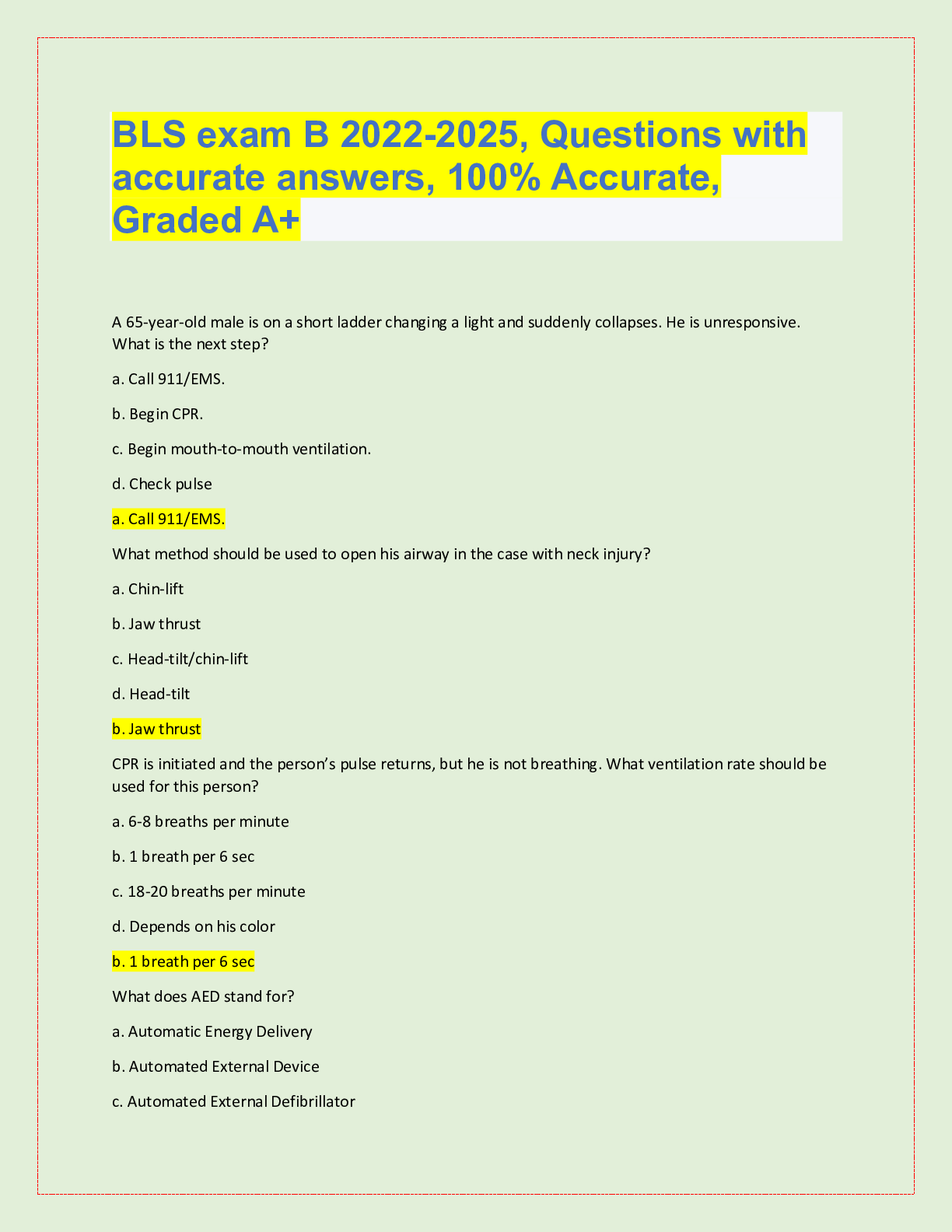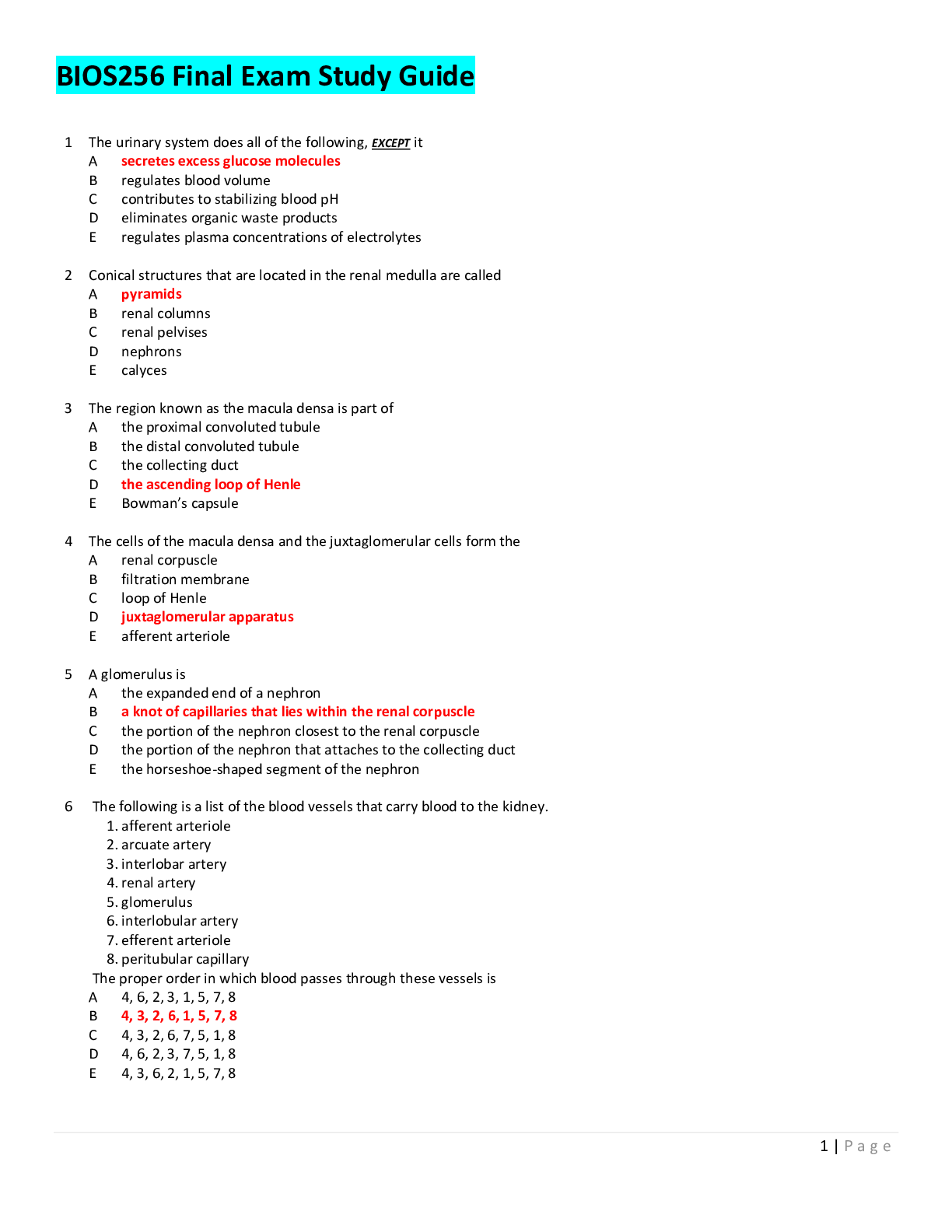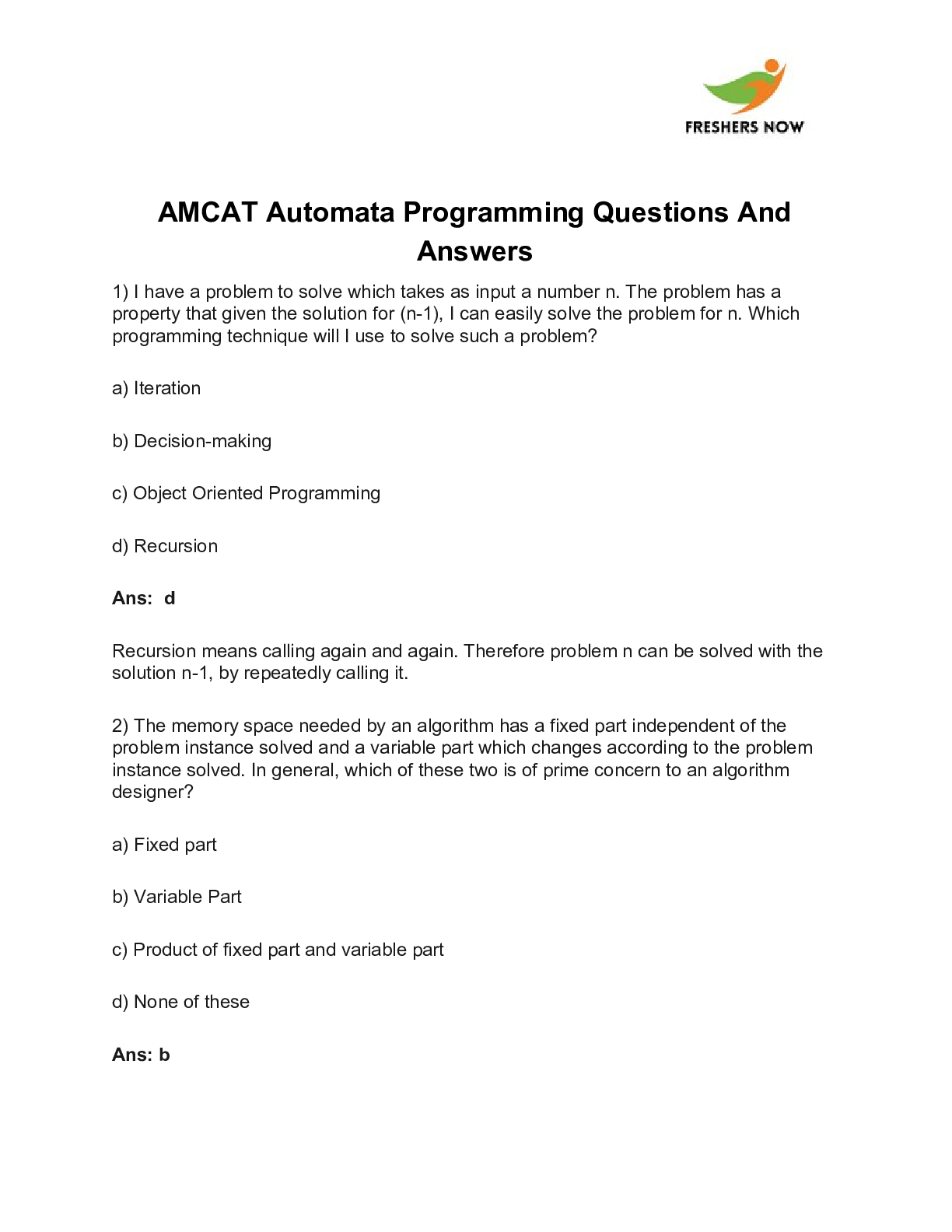Military Science > QUESTIONS & ANSWERS > MCCC Entrance Exam (May 2022) Questions with accurate answers, 100% Accurate, rated A+ (All)
MCCC Entrance Exam (May 2022) Questions with accurate answers, 100% Accurate, rated A+
Document Content and Description Below
MCCC Entrance Exam (May 2022) Questions with accurate answers, 100% Accurate, rated A+ Troop Leading Procedures (TLPs) - ✔✔-Step 1 - Receive the mission. Step 2 - Issue a warning order. Step... 3 - Make a tentative plan. Step 4 - Initiate movement. Step 5 - Conduct reconnaissance. Step 6 - Complete the plan. Step 7 - Issue the order. Step 8 - Supervise and refine. Dynamic process used by small-unit leaders to analyze a mission, develop a plan and prepare for an operation Tenets and Foundations of Unified Land Operations - ✔✔-Simultaneity Depth Synchronization Flexibility Steps of IPB (Intelligence Preparation of the Battlefield) - ✔✔-1) Define the Operational Environment (conditions, circumstances, and influences that affect the employment of capabilities) 2) Describe Environmental Effects on Operations (terrain, weather, civil considerations, and friendly forces) 3) Evaluate the Threat 4) Determine Threat COAs The Mission Statement - ✔✔-Who (unit) What (Unit's essential task and type of operation) When (time give in the higher level order) Where (OBJ or location) Why (unit's purpose, taken from higher's concept of the operation) Decisive Point - ✔✔-A geographic place, specific key event, critical factor, or function that, when acted upon, allows commanders to gain a marked advantage over an adversary or contribute materially to achieving success. Offensive Tasks - ✔✔-1. Movement to Contact (develop the situation and to establish or regain contact) 2. Attack (destroys or defeats enemy forces, seizes and secures terrain, or both) 3. Exploitation (usually follows a successful attack and is designed to disorganize the enemy in depth) 4. Pursuit (catch or cut off a hostile force attempting to escape, with the aim of destroying it) Defensive Tasks - ✔✔-1. Area defense (denying enemy forces access to designated terrain for a specific time rather than destroying the enemy outright) 2. Mobile defense (destruction or defeat of the enemy through a decisive attack by a striking force) 3. Retrograde (organized movement away from the enemy. Delay, withdrawal, withdrawal under pressure, retirement) Characteristics of the Offense - ✔✔-Surprise Concentration Audacity Tempo Characteristics of the Defense - ✔✔-Disruption Flexibility Maneuver Mass/Concentration Operations in Depth Preparation Security Engagement Area Development - ✔✔-1) Identify all likely enemy avenues of approach 2) Determine likely enemy schemes of maneuver 3) Determine where to kill the enemy force 4) Plan and integrate obstacles 5) Emplace weapon systems 6) Plan and integrate indirect fires 7) Rehearse Levels of War - ✔✔-1) Strategic level focuses on supporting national goals 2) Operational level concerns forces collectively in theater 3) Tactical level involves the details of individual engagements Fundamentals of Reconnaissance - ✔✔-EDORRGD: Ensure continuous reconnaissance. Do not keep reconnaissance assets in reserve. Orient on the reconnaissance objective. Report information rapidly and accurately. Retain freedom of maneuver. Gain and maintain enemy contact. Develop the situation rapidly. Fundamentals of Security - ✔✔-PPOPM: 1. Provide early and accurate warning 2. Provide reaction time and maneuver space 3. Orient on the force or facility to be secured 4. Perform continuous recon 5. Maintain enemy contact Principles of Direct Fire Control - ✔✔-MADE MP3: Mass the effects of fire. Avoid target overkill. Destroy the greatest threat first. Employ the best weapon for specific target. Minimize exposure. Plan and implement fratricide avoidance measures. Plan for limited visibility conditions. Plan for degraded capabilities. Direct Fire Control Measures - ✔✔-TERRAIN-BASED FIRE CONTROL MEASURES -Target reference point -Engagement area -Sector of fire -Direction of fire -Terrain-based quadrant -Maximum engagement line -restrictive fire line -final protective line THREAT-BASED FIRE CONTROL MEASURES -Rules of engagement -Weapons ready posture -Weapons safety posture (Loaded, Locked, Prepared, Cleared) -Weapons control status -Engagement priorities -Friendly-based quadrant -Trigger -Engagement techniques -Fire patterns (frontal, cross, depth) -Target array Weapons Control Status - ✔✔-Weapons Control Status: 1) Weapons Hold. Engage only if engaged or ordered to engage 2) Weapons Tight. Engage only targets that are positively identified as enemy 3) Weapons Free. Engage any targets that are not positively identified as friendly Forms of Maneuver - ✔✔-Envelopment Turning Movement Infiltration Penetration Frontal Assault Movement Formations - ✔✔-Column Wedge Line Echelon L/R Vee Staggered Column File (PLT) Box (TM) Diamond (TM) Coil (PLT) Herringbone (PLT) Movement Techniques - ✔✔-Traveling Traveling Overwatch Bounding Overwatch Tenets of Breaching Operations - ✔✔-IFOMS 1. Intelligence 2. Fundamentals 3. Organization 4. Mass 5. Synchronization Fundamentals of Breaching - ✔✔-1. Suppress 2. Obscure 3. Secure 4. Reduce 5. Assault Elements of Combat Power - ✔✔-Leadership Information Command and Control Movement and Maneuver Intelligence Fires Sustainment Protection Warfighting Functions - ✔✔-Command and Control Movement and Maneuver Intelligence Fires Sustainment Protection Military Aspects of Terrain - ✔✔-Obstacles Avenues of Approach Key Terrain Observation and Fields of Fire Cover and Concealment Five Paragraphs of the OPORD - ✔✔-1. Situation 2. Mission 3. Execution 4. Sustainment 5. Command and Signal Commander's Critical Information Requirements - ✔✔-A commander's critical information requirement is an information requirement identified by the commander as being critical to facilitating timely decision-making. The two key elements are friendly force information requirements (need to know about friendly or support force) and priority intelligence requirements (need to know about the enemy or environment) Specified by a commander for a specific operation. Applicable only to the commander who specifies it. Situation dependent—directly linked to a current or future mission. Time-sensitive. Mission Variables - ✔✔-Mission Enemy Time Terrain and Weather Troops and Support Available Civil Considerations AN ATTACK BY FIRE OR OTHER DESTRUCTIVE MEANS FROM CONCEALED POSITIONS ON A MOVING OR TEMPORARILY HALTED ENEMY - ✔✔-AMBUSH A TACTICAL MISSION TASK IN WHICH A COMMANDER USES DIRECT FIRES, SUPPORTED INDIRECT FIRES, TO ENGAGE AN ENEMY FORCE WITHOUT CLOSING WITH THE ENEMY TO DESTROY, SUPPRESS, FIX, OR DECEIVE THAT ENEMY - ✔✔-ATTACK BY FIRE A TACTICAL MISSION TASK THAT DENIES THE ENEMY ACCESS TO AN AREA OR PREVENTS HIS ADVANCE IN A DIRECTION OR ALONG AN AVENUE OF APPROACH - ✔✔-BLOCK A TACTICAL MISSION TASK IN WHICH THE UNIT EMPLOYS ALL AVAILABLE MEANS TO BREAK THROUGH OR ESTABLISH A PASSAGE THROUGH AN ENEMY DEFENSE, OBSTACLE, MINEFIELD, OR FORTIFICATION - ✔✔-BREACH A TACTICAL MISSION TASK IN WHICH THE COMMANDER DIRECTS HIS UNIT TO MANEUVER AROUND AN OBSTACLE, POSITION, OR ENEMY FORCE TO MAINTAIN THE MOMENTUM OF THE OPERATION WHILE DELIBERATELY AVOIDING COMBAT WITH AN ENEMY FORCE - ✔✔-BYPASS A tactical mission task in which the commander restricts enemy movement to a narrow zone by exploiting terrain coupled with the use of obstacles, fires, or friendly maneuver - ✔✔-Canalize A tactical mission task that requires the commander to stop, hold, or surround enemy forces or to cause them to center their activity on a given front and prevent them from withdrawing any part of their forces for use elsewhere - ✔✔-Contain A tactical mission task that requires the commander to maintain physical influence over a specified area to prevent its use by an enemy or to create conditions necessary for successful friendly operations - ✔✔-Control Attack by part or all of a deafening force against an enemy attacking force, for such specific purposes as regaining ground lost, or cutting off or destroying enemy advance units, and with the general objective of denying to the enemy the attainment of the enemy's purpose in attacking. In sustained defensive operations, it is undertaken to restore the battle position and is directed at limited objectives - ✔✔- Counterattack A tactical mission task that requires the commander to remove all enemy forces and eliminate organised resistance within an assigned area - ✔✔-Clear To slow the time of arrival of enemy forces or capabilities or alter the ability of the enemy or adversary to project forces or capabilities - ✔✔-Delay A tactical mission task that physically renders an enemy force combat-ineffective until it is reconstituted. Alternatively, to destroy a combat system is to damage it so badly that it cannot perform any function or be restored to a usable condition without being entirely rebuilt - ✔✔-Destroy A tactical mission task in which a commander integrates direct and indirect fires, terrain, and obstacles to upset an enemy's formation or tempo, interrupt his timetable, or cause enemy forces to commit prematurely to attack in piecemeal fashion - ✔✔-Disrupt A tactical mission task in which a second committed force follows a force conducting an offensive task and is prepared to continue the mission if the lead force is fixed, attrited, or unable to continue - ✔✔- Follow and Assume A tactical mission task in which a committed force follows and supports a lead force conducting an offensive task - ✔✔-Follow and Support A tactical mission task where a commander prevents the enemy from moving any part of his force from a specific location for a specific period - ✔✔-Fix A tactical mission task where the commander prevents, disrupts, or delays the enemy's use of an area or route - ✔✔-Interdict A tactical mission task that requires a unit to seal off--both physically and psychologically--an enemy from sources of support, deny the enemy freedom of movement, and prevent the isolated enemy force from having contact with other enemy forces - ✔✔-Isolate A tactical mission task that results in rendering enemy personnel or materiel incapable of interfering with a particular operation - ✔✔-Neutralize A tactical mission task that involves a force moving a friendly force into an area so that it can control that area. Both the force's movement to and the occupation of the area occur without enemy opposition - ✔✔-Occupy An operation in which a force moves forward or rearward through another force's combat positions with the intention of moving into or out of contact with the enemy - ✔✔-Passage of Lines An operation in which, by direction of higher authority, all or part of a unit is replaced in an area by the incoming unit and the responsibilities of the replaced elements for the mission and the assigned zone of operations are transferred to the incoming unit - ✔✔-Relief in Place A tactical mission task in which the commander ensures that a terrain feature controlled by a friendly force remains free of enemy occupation or use - ✔✔-Retain A form of retrograde in which a force out of contact moves away from the enemy - ✔✔-Retirement A tactical mission task that involves preventing a unit, facility, or geographical location from being damaged or destroyed as a result of enemy action - ✔✔-Secure A tactical mission task that involves taking possession of a designated area using overwhelming force - ✔✔-Seize A tactical mission task in which a maneuver force moves to a position where it can engage the enemy by direct fire in support of another maneuvering force - ✔✔-Support by Fire A tactical mission task that results in temporary degradation of the performance of a force or weapons system below the level needed to accomplish the mission - ✔✔-Suppress A tactical mission task that involves forcing an enemy force from one avenue of approach or mobility corridor to another - ✔✔-Turn A planned retrograde operation in which a force in contact disengages from an enemy force and moves in a direction away from the enemy - ✔✔-Withdraw A planned retrograde operation in which a force in contact disengages from an enemy force and moves in a direction away from the enemy - ✔✔-Withdraw Under Pressure A tactical obstacle effect that integrates fire planning and obstacle effort to divert an enemy formation from one avenue of approach to an adjacent avenue of approach or into an engagement area - ✔✔-Turn An obstacle effect that integrates fire planning and obstacle effort to stop an attacker along a specific avenue of approach or to prevent the attacking force from passing through an engagement area - ✔✔- Block An obstacle effect that focuses fire planning and obstacle effort to cause the enemy to break up his formation and tempo, interrupt his timetable, commit breaching assets prematurely, and attack in a piecemeal effort - ✔✔-Disrupt An obstacle effect that focuses fire planning and obstacle effort to slow an attacker's movement within a specified area, normally an engagement area - ✔✔-Fix In land warfare, a point on the terrain, easily identifiable, where two or more units are required to make contact - ✔✔-Contact Point The point where two infiltrating elements in the same or different infiltration lanes are scheduled to meet to consolidate before proceeding on with their missions - ✔✔-Linkup Point An immediately available prearranged barrier of fire designed to impede enemy movement across defensive lines or areas - ✔✔-Final Protective Fire (FPF) A phase line crossed at a p [Show More]
Last updated: 2 years ago
Preview 1 out of 50 pages

Buy this document to get the full access instantly
Instant Download Access after purchase
Buy NowInstant download
We Accept:

Reviews( 0 )
$12.00
Can't find what you want? Try our AI powered Search
Document information
Connected school, study & course
About the document
Uploaded On
Mar 17, 2023
Number of pages
50
Written in
Additional information
This document has been written for:
Uploaded
Mar 17, 2023
Downloads
0
Views
92
















, Question Answers, 100% Correct , Correct Answers.png)

.png)
, Question Answers, Correct , Correct Answers.png)





